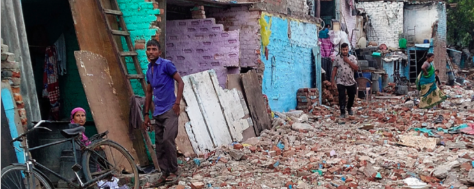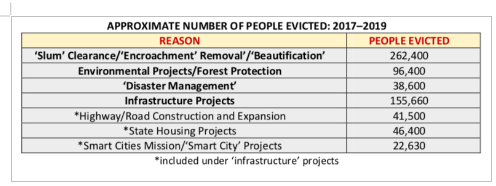COVID-19: Close to 20,000 People Forcefully Evicted from their Homes During the Lockdown

With the threat of the COVID-19 pandemic still looming large, people across the world are being advised to stay home. However, how does one without a home do so? Over 14.9 million people across India currently face the threat of eviction and displacement as a result of infrastructure and environmental projects, disaster management efforts and ‘city-beautification/slum-clearance’ drives. A report released by the Housing and Land Rights Network (HLRN) on August 18 documented this crisis.
India has no official data on the state of evictions. The report elaborated on how the pandemic was used to evict people from their houses on the pretext of infrastructural projects and beautification, among other reasons. The report mentions that despite the widespread prevalence of the pandemic and the high number of COVID-19 cases in India, 20,000 people were evicted during the pandemic (between March 16 and July 31, 2020). This was done with the Indian government ignoring directives issued by the World Health Organization, as well as a guidance note by the UN Special Rapporteur on Adequate Housing which prohibited evictions during the pandemic.
Shivani Chaudhry, HLRN’s executive director told Reuters, “Many of these evictions were likely carried out during the lockdown to take advantage of the curfew-like conditions, when movement of affected persons was restricted and they did not have access to legal remedies, this is indefensible.
Evictions continue even as the government’s Housing for All plan, which aims to create 20 million urban homes and 30 million rural homes by 2022, is failing to address the issue.
HLRN data showed that from 2017 to 2019, Central and state government authorities forcefully evicted a minimum of 5,68,000 (over 5.6 lakh) people and demolished over 1,17,770 houses across urban and rural India. State authorities destroyed at least 108 houses on an average daily, evicting about 519 people every day or 22 people each hour.
“While the above figures are alarming, they are a conservative estimate and present just a part of the real picture, as they only reflect cases known to HLRN. The total number of people evicted and displaced in India as well as those under risk of eviction, therefore, is likely to be much higher than documented,” the organisation said in a press release.
“Evictions were carried out for a range of reasons and under various guises, including: ‘slum clearance/encroachment-removal/city-beautification’ drives (46 per cent of affected people); infrastructure and ostensible ‘development’ projects (27 per cent); environmental projects, forest protection, and wildlife conservation (17 per cent); ‘disaster management’ efforts (seven per cent); and other reasons such as political rallies (three percent of the total affected population),” the release said.
Resettlement was provided in only about 26% of the documented cases of eviction in 2019. “In the absence of resettlement for the vast majority, affected persons have had to make their own provisions for alternative housing or have been rendered homeless,” HLRN said.
Recently, 600 families of domestic workers and construction workers who were living in shanties in Gurugram, were rendered homeless as their houses were razed for the alleged construction of a biodiversity park in the region. No compensation, notice or rehabilitation was given to them.

Given the pandemic, activists have called on state governments to impose an immediate moratorium on evictions or provide adequate alternative housing with basic facilities within a vicinity of two to three kilometres.
Get the latest reports & analysis with people's perspective on Protests, movements & deep analytical videos, discussions of the current affairs in your Telegram app. Subscribe to NewsClick's Telegram channel & get Real-Time updates on stories, as they get published on our website.























